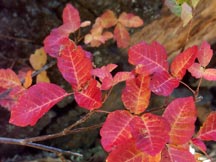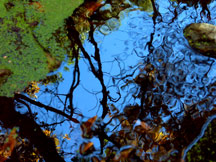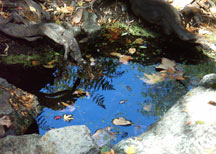

This one was one of the absolute best! This group had perhaps the best work ethic of any. I was impressed that after a long hard day climbing Pinnacles and digesting some tough (tuff?) geology lectures, that even without being asked, they were all there seating themselves in a semi-circle near the telescopes waiting for me to make my entrance right after dinner Saturday evening. So it was cosmic justice that this dedicated group was treated to the full-on shock-and-awe optical firepower of (1) Cabrillo's f/4 8" LXD75 Schmidt-Newtonian, Kirk B's 12" Dob, Jack Davis' 12" Dobsonian, and best of all - JP came down from Ukiah and treated us to his 25" reflector aimed at one celestial wonder after another. The big 25 incher was essential in showing us the real structure of galaxies, of core-collapse globular clusters, and the disk structure of edge-on spirals.
Friday night, I continued the earlier planetarium lecture on the origin of the solar system with the origin and evolution of all stars, concluding with how supernovae are the fate of the largest stars. As night fell, I used my laser to point out red giants Antares and Arcturus, and blue giant Deneb, and then the critical role of rare carbon stars in spreading carbon (life!) through the galaxy. Then, it was time to man the scopes... These shots were taken with the camera on ISO 800 and so are pretty grainy. Unfortunately, many of my Saturday day time shots are also at this setting also, before I noticed. Sorry!
Saturday. My hip surgery recovery continues, and I pushed to a new level by doing the geology hike for the first time now in 10 years. I am very glad I did, as I enjoyed giving my lecture on the cosmic genesis of the chemical elements and their relation to the abundances of the earth's elements. And on the trail this time.
After my lecture, I turned around and did the 4 mile walk back down to camp at a leisurely pace. Time enough to do some beautiful Fall colors photography in the canyon below the Visitor's Center. The creek had millions of tiny water plants with micro leaves covering the surface, making a dimpled ocean of green from above.
 |
 |
 |
Back from the hike, it was time for a session of solar viewing, and then another epic group feast.
|
Patti was amazing! Bringing a ton of tri tip steak for BBQ'ing. |
I put together a quick target list for my astrophotography demonstrations, here. Chris and I had two excellent long nights of photography. I love spending quiet time under the Universe and capturing its beauty. My students enjoy watching and learning too. Here's what I did on this trip... All images were taken with the 8" f/4 Meade LXD75 on a GM8 mount, with CCDOPS ver 5, sRGB+gamma single-shot color processed, then stacked in Registax 3, and post-processed in Photoshop CS2 and with Astronomy Tools Photoshop actions (shown in single quotes).
The Jellyfish Nebula and Mu Geminorum. 3x5min stack. Photoshop 'make stars smaller', 2x 'space noise redux', 'deep space noise redux', levels, slight saturation enhance. This was only a "proof of concept" attempt, in preparation for helping a friend do this one right. The "jellyfish" extends off the bottom of this picture. |
M77 Seyfert and NGC 1055 in Cetus. M77 is the brightest active galaxy in the sky, and NGC 1055 is an edge-on spiral. 4x5min stack. Photoshop 2x 'make stars smaller', 'space noise redux', 'deep space noise redux', 'local contrast enhance', levels. Compare to this APOD photo |
|
IC 348 in Perseus. This beautiful reflection nebula in an extremely young cluster, next to Omicron Persei, includes a large amount of dust which only faintly reflects, and hides stars on the right side of the image. 9x5 min stack. 3x 'make stars smaller', 2x 'space noise redux', 'deep space noise redux', Then saved, and resaved at different levels, combined using the HDR option, 32->16bit conversion by exposure/gamma, then the 16bit version adjusted further with levels, saturation, 'local contrast enhancement'. No cropping. |
NGC 891 in Andromeda. 9x5min stack. Photoshop 3x 'make stars smaller', 2x 'space noise redux', 'deep space noise redux', 3x 'local contrast enhance', levels. This galaxy is only 13' long (only 1.8 times the length of NCG 1055 in the previous picture) and the frame is severely cropped. An 8" f/4 at prime focus doesn't have the magnification to do this properly. But, it's still SUCH a beautiful galaxy! |
Sunday and Fremont Peak State Park
|
Jen spots a deposit of travertine |
Thanks people! It was a great weekend!